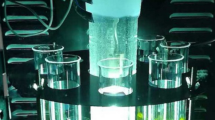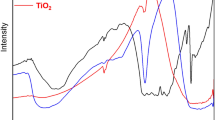Abstract
A TiO2/g-C3N4 composite photocatalytic film was prepared by in situ synthesis method and its photocatalytic capability under weak-visible-light condition was studied. The co-precursor with different ratio of melamine and TiO2 sol-gel precursor were treated using ultrasonic mixing, physical deposition, and co-sintering method to form the smooth, white-yellow, and compact TiO2/g-C3N4 composite films. The prepared TiO2/g-C3N4 materials were characterized by SEM, TEM, EDS, XRD, BET, VBXPS, and UV-vis diffuse reflectance spectra. The results of composite showed that TiO2 and g-C3N4 have close interfacial connections which are favorable to charge transfer between these two semiconductors with suitable band structure, g-C3N4 retard the anatase-to-rutile phase transition of TiO2 significantly, the specific surface area were increased with g-C3N4 ratio raised. Under weak-light irradiation, composite films photocatalytic experiments exhibited RhB removal efficiency approaching 90% after three recycles. Powders suspension degradation experiments revealed the removal efficiency of TiO2/g-C3N4 (90.8%) was higher than pure TiO2 (52.1%) and slightly lower than pure g-C3N4 (96.6%). By control experiment, the enhanced photocatalysis is ascribed to the combination of TiO2 and g-C3N4, which not only produced thin films with greater stability but also formed heterojunctions that can be favorable to charge transfer between these two semiconductors with suitable band structure. This study presents the potential application of photocatalytic film in the wastewater treatment under weak-light situation.











Similar content being viewed by others
References
An N, Liu H, Ding Y, Lu B, Zhang M (2012) Fabrication of micro-structures on a PVDF/TiO2 nano-composite film using photocatalytic lithography. Appl Surf Sci 258:5052–5055
And CNR, Jr JTY (2000) Photochemistry of NO chemisorbed on TiO2(110) and TiO2 powders. J Phy s Chem B 104:1729–1737
Barton I, Matejec V, Matousek J (2016) Photocatalytic activity of nanostructured TiO2 coating on glass slides and optical fibers for methylene blue or methyl orange decomposition under different light excitation. J Photochem Photobiol A Chem 317:72–80
Boonprakob N, Wetchakun N, Phanichphant S, Waxler D, Sherrell P, Nattestad A, Chen J, Inceesungvorn B (2014) Enhanced visible-light photocatalytic activity of g-C3N4/TiO2 films. J Colloid Interface Sci 417:402–409
Chong MN, Jin B, Chow CW, Saint C (2010) Recent developments in photocatalytic water treatment technology: a review. Water Res 44:2997–3027
Dong S, Feng J, Fan M, Pi Y, Hu L, Han X, Liu M, Sun J, Sun J (2015) Recent developments in heterogeneous photocatalytic water treatment using visible light-responsive photocatalysts: a review. RSC Adv 5:14610–14630
Dostanić J, Grbić B, Radić N, Stojadinović S, Vasilić R, Vuković Z (2013) Preparation and photocatalyic properties of TiO2-P25 film prepared by spray pyrolysis method. Appl Surf Sci 274:321–327
Fan X, Xing Z, Shu Z, Zhang L, Wang L, Shi J (2015) Improved photocatalytic activity of g-C3N4 derived from cyanamide-urea solution. RSC Adv 5:8323–8328
Fu G, Vary PS, Lin CT (2005) Anatase TiO2 nanocomposites for antimicrobial coatings. J Phys Chem B 109:8889–8898
Gao F, Wang Y, Shi D, Zhang J, Wang M, Jing X, Humphry-Baker R, Wang P, Zakeeruddin SM, Grätzel M (2008) Enhance the optical absorptivity of nanocrystalline TiO2 film with high molar extinction coefficient ruthenium sensitizers for high performance dye-sensitized solar cells. J Am Chem Soc 130:10720–10728
Garlisi C, Palmisano G (2017) Radiation-free superhydrophilic and antifogging properties of e-beam evaporated TiO2 films on glass. Appl Surf Sci 420:83–93
Guo X, Rao L, Wang P, Wang C, Ao Y, Jiang T, Wang W (2018) Photocatalytic properties of P25-doped TiO2 composite film synthesized via sol–gel method on cement substrate. J Environ Sci 66:71–80
Hao R, Wang G, Jiang C, Tang H, Xu Q (2017) In situ hydrothermal synthesis of g-C3N4 /TiO2 heterojunction photocatalysts with high specific surface area for rhodamine B degradation. Appl Surf Sci 411:400–410
Hu B, Wang P, Zhang N, Chao W, Ao Y (2016a) Photoproduction of dissolved organic carbon and inorganic nutrients from resuspended lake sediments. Environ Sci Pollut Res 23:1–10
Hu W, Zhou W, Zhang K, Zhang X, Wang L, Jiang B, Tian G, Zhao D, Fu H (2016b) Facile strategy for controllable synthesis of stable mesoporous black TiO2 hollow spheres with efficient solar-driven photocatalytic hydrogen evolution. J Mater Chem A 4:7495–7502
Jiang B, Zhang S, Guo X, Jin B, Tian Y (2009) Preparation and photocatalytic activity of CeO2 /TiO2 interface composite film. Appl Surf Sci 255:5975–5978
Keshmiri M, Mohseni M, Troczynski T (2004) Development of novel TiO2 sol–gel-derived composite and its photocatalytic activities for trichloroethylene oxidation. Appl Catal B Environ 53:209–219
Kumar SG, Rao KS (2014) Polymorphic phase transition among the titania crystal structures using a solution-based approach: from precursor chemistry to nucleation process. Nano 6:11574–11632
Li L, Cheng B, Wang Y, Yu J (2015) Enhanced photocatalytic H2-production activity of bicomponent NiO/TiO2 composite nanofibers. J Colloid Interface Sci 449:115–121
O'Regan B, Grätzel M (1991) A low-cost, high-efficiency solar cell based on dye-sensitized colloidal TiO2 films. Nature 353:737–740
Robertson AR (1977) The CIE 1976 color-difference formulae. Color Res Appl 2:7–11
Shiraishi Y, Kanazawa S, Sugano Y, Tsukamoto D, Sakamoto H, Ichikawa S, Hirai T (2016) Highly selective production of hydrogen peroxide on graphitic carbon nitride (g-C3N4) photocatalyst activated by visible light. ACS Catal 4:774–780
Sun Y, Yan K (2016) Sol-gel modified TiO2 powder composite films for photoelectrochemical hydrogen generation. J Adv Oxid Technol 19:376–380
Tang H, Prasad K, Sanjines R, Schmid PE, Levy F (1994) Electrical and optical properties of TiO2 anatase thin films. J Appl Phys 75:2042–2047
Thormählen I, Straub J, Grigull U (1985) Refractive index of water and its dependence on wavelength, temperature, and density. J Phys Chem Ref Data 14:933–945
Roméas V, Pierre Pichat, Guillard C, Thierry Chopin A, Lehaut‡ C (1999) Testing the efficacy and the potential effect on indoor air quality of a transparent self-cleaning TiO2-coated glass through the degradation of a Fluoranthene layer. Ind Eng Chem Res 38:3878–3885
Wei Z, Liang F, Liu Y, Luo W, Wang J, Yao W, Zhu Y (2017) Photoelectrocatalytic degradation of phenol-containing wastewater by TiO2/gC3N4 hybrid heterostructure thin film. Appl Catal B Environ 201:600–606
Xu L, Nan C, Li Y, Deng D, Xing X, Wang Y (2016) A general nonaqueous sol-gel route to g-C3N4-coupling photocatalysts: the case of Z-scheme g-C3N4/TiO2with enhanced photodegradation toward RhB under visible-light. Sci Rep 6:39531
Yan H, Yang H (2011) TiO2–g-C3N4 composite materials for photocatalytic H2 evolution under visible light irradiation. J Alloys Compd 509:L26–L29
Yan SC, Li ZS, Zou ZG (2009) Photodegradation performance of g-C3N4 fabricated by directly heating melamine. Langmuir 25:10397–10401
Ye L, Chen S (2016) Fabrication and high visible-light-driven photocurrent response of g-C3N4 film: the role of thiourea. Appl Surf Sci 389:1076–1083
Yoko T, Yuasa A, Kamiya K, Sakka S (2010) ChemInform abstract: sol-gel-derived TiO2 film semiconductor electrode for photocleavage of water. Preparation and effects of postheating treatment on the photoelectrochemical behavior. ChemInform 22:no
Zang Y, Li L, Xu Y, Zuo Y, Li G (2014) Hybridization of brookite TiO2 with g-C3N4: a visible-light-driven photocatalyst for As3+ oxidation, MO degradation and water splitting for hydrogen evolution. J Mater Chem A 2:15774–15780
Zhang L, Fang M (2010) Nanomaterials in pollution trace detection and environmental improvement. Nano Today 5:128–142
Zhang L, Jing D, She X, Liu H, Yang D, Lu Y, Li J, Zheng Z, Guo L (2014a) Heterojunctions in g-C3N4 /TiO2(B) nanofibres with exposed (001) plane and enhanced visible-light photoactivity. J Mater Chem A 2:2071–2078
Zhang M, Xu J, Zong R, Zhu Y (2014b) Enhancement of visible light photocatalytic activities via porous structure of g-C3N4. Appl Catal B Environ 147:229–235
Zhou W, Li W, Wang JQ, Qu Y, Yang Y, Xie Y, Zhang K, Wang L, Fu H, Zhao D (2014) Ordered mesoporous black TiO2 as highly efficient hydrogen evolution photocatalyst. J Am Chem Soc 136:9280–9283
Acknowledgements
We are grateful for grants from the National Science Funds for Creative Research Groups of China (No.51421006), the National Major Projects of Water Pollution Control and Management Technology (No. 2017ZX07204003), and the Qing Lan Project of Jiangsu province and PAPD.
Author information
Authors and Affiliations
Corresponding author
Additional information
Responsible editor: Suresh Pillai
Rights and permissions
About this article
Cite this article
Wang, P., Guo, X., Rao, L. et al. A weak-light-responsive TiO2/g-C3N4 composite film: photocatalytic activity under low-intensity light irradiation. Environ Sci Pollut Res 25, 20206–20216 (2018). https://doi.org/10.1007/s11356-018-2201-1
Received:
Accepted:
Published:
Issue Date:
DOI: https://doi.org/10.1007/s11356-018-2201-1




